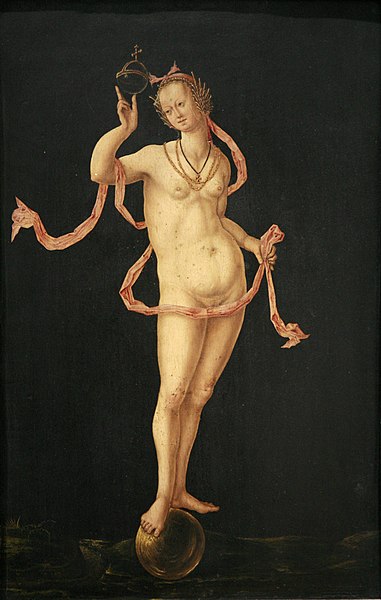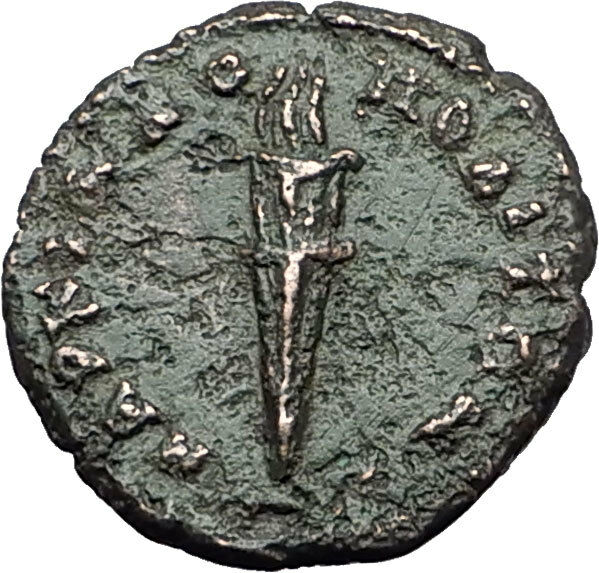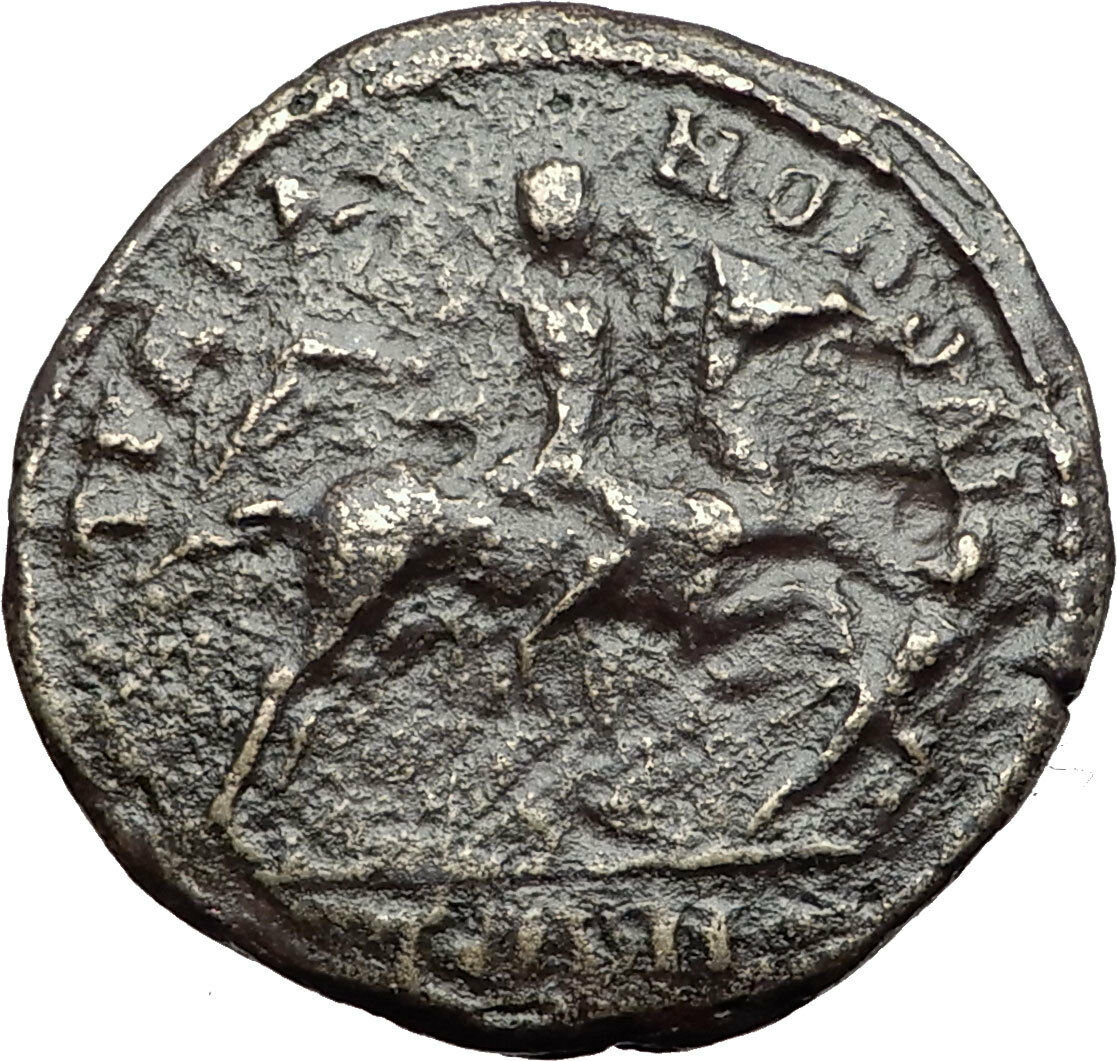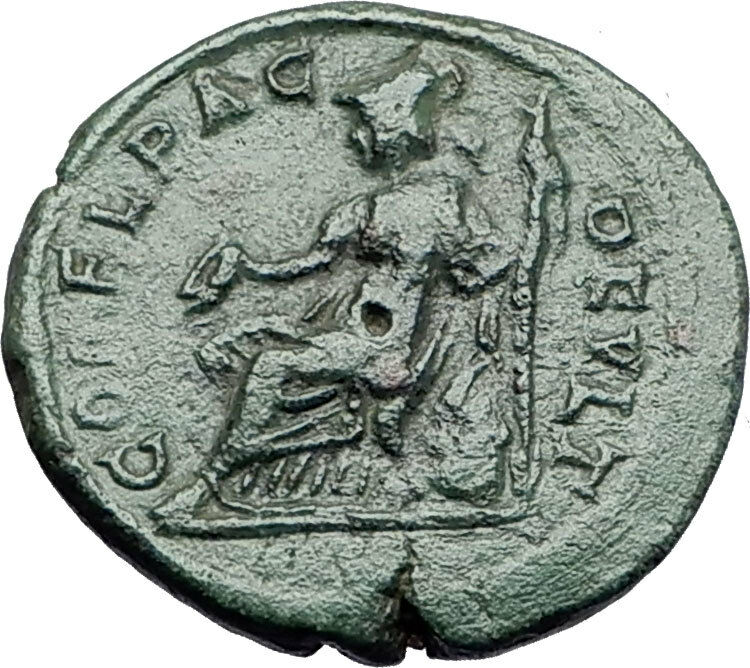|
Gordian III – Roman Emperor: 238-244 A.D. –
Bronze 18mm (2.66 grams) from Marcianopolis in Moesia Inferior.
M
AVT ΓOPΔIANOC AV, Laureate, draped bust right.
MAPKIANOΠOΛITΩN, Tyche standing facing, holding rudder over globe
and cornucopia..
You are bidding on the exact
item pictured, provided with a Certificate of Authenticity and Lifetime
Guarantee of Authenticity.
Tyche (pronounced Too-kee; Greek for luck; the Roman equivalent was Fortuna)
was the presiding tutelary deity that governed the fortune and prosperity of a
city, its destiny. Increasingly during the Hellenistic period, cities had their
own specific iconic version of Tyche, wearing a mural crown (a crown like the
walls of the city).
Fortuna (Latin:
Fortūna, equivalent to the
Greek
goddess
Tyche
) was the goddess of fortune and
personification
of
luck in
Roman religion
. She might bring good luck or
bad: she could be represented as veiled and blind, as in modern depictions of
Justice
, and came to represent life’s
capriciousness. She was also a goddess of
fate
: as Atrox Fortuna, she claimed the
young lives of the
princeps
Augustus
‘ grandsons
Gaius
and
Lucius
, prospective heirs to the Empire.
Her father was said to be Jupiter and like him, she could also be bountiful . As
Annonaria
she protected grain supplies.
June 11 was sacred to her: on June 24 she was given cult at the festival of
Fors Fortuna
.
Cult

Fortuna and Pontos
Fortuna’s Roman cult was variously attributed to
Servius Tullius
– whose exceptional good
fortune suggested their sexual intimacy
– and to
Ancus Marcius
.
The two earliest temples mentioned in Roman Calendars were outside the city, on
the right bank of the Tiber (in Italian
Trastevere
). The first temple dedicated to Fors
was attributed to the Etruscan Servius Tullius, while the second is known to
have been built in 293 BC as the fulfilment of a Roman promise made during later
Etruscan wars
[6]
The date of dedication of her temples was 24 June, or Midsummer’s Day, when
celebrants from Rome annually floated to the temples downstream from the city.
After undisclosed rituals they then rowed back, garlanded and inebriated.[7]
Also Fortuna had a temple at the
Forum Boarium
. Here Fortuna was twinned with
the cult of
Mater Matuta
(the goddesses shared a festival
on 11 June), and the paired temples have been revealed in the excavation beside
the church of
Sant’Omobono
: the cults are indeed archaic in
date.[8]
Fortuna Primigenia of
Praeneste
was adopted by Romans at the end of
3rd BC in an important cult of Fortuna Publica Populi Romani (the
Official Good Luck of the Roman People) on the
Quirinalis
outside the
Porta Collina
.[9]
No temple at Rome, however, rivalled the magnificence of the Praenestine
sanctuary.

Fortuna lightly balances the
orb
of sovereignty between thumb
and finger in a Dutch painting of ca 1530
(Musée
des Beaux-Arts de Strasbourg)
Fortuna’s identity as personification of chance events was closely tied to
virtus
(strength of character). Public
officials who lacked virtues invited ill-fortune on themselves and Rome:
Sallust
uses the infamous
Catiline
as illustration – “Truly, when in the
place of work, idleness, in place of the
spirit of measure and equity
, caprice and pride
invade, fortune is changed just as with morality”.
An oracle
at the
Temple of Fortuna Primigena
in
Praeneste
used a form of divination in which a
small boy picked out one of various futures that were written on
oak
rods. Cults to Fortuna in her many forms are attested throughout the Roman
world. Dedications have been found to Fortuna Dubia (doubtful fortune),
Fortuna Brevis (fickle or wayward fortune) and Fortuna Mala (bad
fortune).
She is found in a variety of domestic and personal contexts. During the early
Empire, an amulet from the
House of Menander
in
Pompeii
links her to the Egyptian goddess
Isis, as Isis-Fortuna.[11]
She is functionally related to the God
Bonus Eventus
,[12]
who is often represented as her counterpart: both appear on
amulets
and intaglio
engraved gems
across the Roman world.
Her name seems to derive from Vortumna (she who revolves the year).[citation
needed]
The earliest reference to
the Wheel of Fortune
, emblematic of the endless
changes in life between prosperity and disaster, is from 55 BC.
In
Seneca
‘s tragedy Agamemnon, a chorus
addresses Fortuna in terms that would remain almost proverbial, and in a high
heroic ranting mode that Renaissance writers would emulate:
“O Fortune, who dost bestow the throne’s high boon with mocking hand, in
dangerous and doubtful state thou settest the too exalted. Never have
sceptres obtained calm peace or certain tenure; care on care weighs them
down, and ever do fresh storms vex their souls. …great kingdoms sink
of their own weight, and Fortune gives way ‘neath the burden of herself.
Sails swollen with favouring breezes fear blasts too strongly theirs;
the tower which rears its head to the very clouds is beaten by rainy
Auster
…. Whatever Fortune has raised
on high, she lifts but to bring low. Modest estate has longer life; then
happy he whoe’er, content with the common lot, with safe breeze hugs the
shore, and, fearing to trust his skiff to the wider sea, with
unambitious oar keeps close to land.”
Ovid
‘s description is typical of Roman
representations: in a letter from exile
he reflects ruefully on the “goddess who admits by her unsteady wheel her own
fickleness; she always has its apex beneath her swaying foot.”
Middle Ages
Fortuna did not disappear from the popular imagination with the ascendancy of
Christianity by any means.
Saint Augustine
took a stand against her
continuing presence, in the
City of God
: “How, therefore, is she good,
who without discernment comes to both the good and to the bad? …It profits one
nothing to worship her if she is truly fortune… let the bad worship
her…this supposed deity”.
In the 6th century, the
Consolation of Philosophy
, by statesman and
philosopher
Boethius
, written while he faced execution,
reflected the Christian theology of casus, that the apparently random and
often ruinous turns of Fortune’s Wheel are in fact both inevitable and
providential, that even the most coincidental events are part of God’s hidden
plan which one should not resist or try to change. Fortuna, then, was a servant
of God,[18]
and events, individual decisions, the
influence of the stars
were all merely vehicles
of Divine Will. In succeeding generations Boethius’ Consolation was
required reading for scholars and students. Fortune crept back in to popular
acceptance, with a new iconographic trait, “two-faced Fortune”, Fortuna
bifrons; such depictions continue into the 15th century.

Albrecht Dürer
‘s engraving of
Fortuna, ca 1502
The ubiquitous image of
the Wheel of Fortune
found throughout the
Middle Ages and beyond was a direct legacy of the second book of Boethius’s
Consolation. The Wheel appears in many renditions from tiny miniatures in
manuscripts
to huge stained glass windows in
cathedrals, such as at
Amiens
. Lady Fortune is usually represented as
larger than life to underscore her importance. The wheel characteristically has
four shelves, or stages of life, with four human figures, usually labeled on the
left regnabo (I shall reign), on the top regno (I reign) and is
usually crowned, descending on the right regnavi (I have reigned) and the
lowly figure on the bottom is marked sum sine regno (I have no kingdom).
Medieval representations of Fortune emphasize her duality and instability, such
as two faces side by side like
Janus
; one face smiling the other frowning;
half the face white the other black; she may be blindfolded but without scales,
blind to justice. She was associated with the
cornucopia
, ship’s rudder, the ball and the
wheel. The cornucopia is where plenty flows from, the Helmsman’s rudder steers
fate, the globe symbolizes chance (who gets good or bad luck), and the wheel
symbolizes that luck, good or bad, never lasts.
Fortune would have many influences in cultural works throughout the Middle
Ages. In
Le Roman de la Rose
, Fortune frustrates the
hopes of a lover who has been helped by a personified character “Reason”. In
Dante’s
Inferno
(vii.67-96)
Virgil
explains the nature of Fortune, both a
devil and a ministering angel, subservient to God.
Boccaccio
‘s De Casibus Virorum Illustrium
(“The Fortunes of Famous Men”), used by
John Lydgate
to compose his
Fall of Princes
, tells of many where the
turn of Fortune’s wheel brought those most high to disaster, and Boccaccio essay
De remedii dell’una e dell’altra Fortuna, depends upon Boethius for the
double nature of Fortuna. Fortune makes her appearance in
Carmina Burana
(see image). The
Christianized Lady Fortune is not autonomous: illustrations for Boccaccio’s
Remedii show Fortuna enthroned in a triumphal car with reins that lead to
heaven,[20]
and appears in chapter 25 of Machiavelli’s
The Prince
, in which he says Fortune only
rules one half of men’s fate, the other half being of their own will.
Machiavelli reminds the reader that Fortune is a woman, that she favours a
strong, or even violent hand, and that she favours the more aggressive and bold
young man than a timid elder. Even
Shakespeare
was no stranger to Lady Fortune:
- When in disgrace with Fortune and men’s eyes
- I all alone beweep my outcast state … —
Sonnet 29
Pars Fortuna in
Astrology

llustration by Al-Biruni (973-1048) of different phases of the moon,
from the Persian Kitab al-tafhim
In Astrology
the term ‘Pars Fortuna’ represents a
mathematical point in the
zodiac
derived by the longitudinal positions of
the Sun
,
Moon and
Ascendant
(Rising sign) in the birth chart of
an individual. It represents an especially beneficial point in the horoscopic
chart. In
Arabic
Astrology
, this point is called
Arabian Parts
.
The procedure followed for fixing one’s Pars Fortuna in ancient and
traditional astrology depended on the time of birth, viz., during daylight or
night time (whether the Sun was above or below the
horizon
). In modern
western astrology
the day time formula only was
used for many years, but with more knowledge of ancient astrology, the two
calculation methods are now often used.
The formula for calculating the day time Part of Fortune (PF) is (using the
360 degree positions for each point):
PF = Ascendant + Moon
–
Sun
The formula for the night-time Part of Fortune is PF = Ascendant + Sun – Moon
Each calculation method results in a different
zodiac
position for the
Part of Fortune
.
Al Biruni
(973 – 1048), an 11th-century
mathematician, astronomer and scholar, who was the greatest proponent of this
system of prediction, listed a total of 97 Arabic Parts, which were widely used
for astrological consultations. Paul Vachier has prepared an Arabic Parts
Calculator for all the Arabic Parts.
Marcianopolis, or Marcianople was an ancient Roman city in
Thracia
. It was located at the site of modern day
Devnya
,
Bulgaria
.
The city was so renamed by Emperor
Trajan
after
his sister
Ulpia Marciana
, and was previously known as Parthenopolis. Romans repulsed a
Gothic
attack to
this town in 267
(or
268), during the
reign of Gallienus
.
Diocletian
made it the capital of the
Moesia Secunda
province.
Valens
made
it his winter quarters in 368 and succeeding years, Emperor
Justinian
I
restored and fortified it. In 587, it was sacked by the king of the
Avars
but at once retaken by the Romans. The Roman army quartered there in
596 before crossing the Danube to assault the Avars.
Between 893 and 972 it was one of the most important medieval cities in
south-eastern Europe.
Marcus Antonius Gordianus Pius (January
20, 225
–
February
11
, 244
),
known in
English
as Gordian III,
 was was
Roman
Emperor
from 238 to 244. Gordian was the son of
Antonia Gordiana
and his father was an unnamed Roman Senator who died before
238. Antonia Gordiana was the daughter of Emperor
Gordian I
and younger sister of Emperor
Gordian II
.
Very little is known on his early life before becoming Roman Emperor. Gordian
had assumed the name of his maternal grandfather in 238.
Rise to power
Following the murder of emperor
Alexander Severus
in Moguntiacum (modern
Mainz
), the
capital of the
Roman province
Germania Inferior
,
Maximinus Thrax
was acclaimed emperor, despite strong opposition of the
Roman senate
and the majority of the population. In response to what was
considered in Rome as a rebellion, Gordian’s grandfather and uncle, Gordian I
and II, were proclaimed joint emperors in the
Africa Province
. Their revolt was suppressed within a month by Cappellianus,
governor of Numidia
and a loyal supporter of Maximinus Thrax. The elder Gordians died,
but public opinion cherished their memory as peace loving and literate men,
victims of Maximinus’ oppression.
Meanwhile, Maximinus was on the verge of marching on Rome and
the Senate elected
Pupienus
and Balbinus
as joint emperors. These senators were not popular men and the population of
Rome was still shocked by the elder Gordian’s fate, so that the Senate decided
to take the teenager Gordian, rename him Marcus Antonius Gordianus as his
grandfather, and raise him to the rank of
Caesar
and imperial heir.
Pupienus
and Balbinus
defeated Maximinus, mainly due to the defection of several
legions
,
namely the
Parthica II
who assassinated Maximinus. But their joint reign was
doomed from the start with popular riots, military discontent and even an
enormous fire that consumed Rome in June 238. On
July 29
,
Pupienus and Balbinus were killed by the
Praetorian guard
and Gordian proclaimed sole emperor.
Rule
Due to Gordian’s age, the imperial government was surrendered
to the aristocratic families, who controlled the affairs of Rome through the
senate. In 240,
Sabinianus
revolted in the African province, but the situation was dealt quickly. In 241,
Gordian was married to Furia Sabinia
Tranquillina
, daughter of the newly appointed praetorian prefect,
Timesitheus
. As chief of the Praetorian guard and father in law of the
emperor, Timesitheus quickly became the de facto ruler of the Roman
empire.
In the 3rd century, the Roman frontiers weakened against the
Germanic tribes across the
Rhine
and
Danube
, and the
Sassanid
kingdom across the
Euphrates
increased its own attacks. When the Persians under
Shapur I
invaded Mesopotamia
, the young emperor opened the doors of the
Temple of Janus
for the last time in Roman history, and sent a huge army to
the East. The Sassanids were driven back over the Euphrates and defeated in the
Battle of Resaena
(243). The campaign was a success and Gordian, who had
joined the army, was planning an invasion of the enemy’s territory, when his
father-in-law died in unclear circumstances. Without Timesitheus, the campaign,
and the emperor’s security, were at risk.
Marcus Julius Philippus, also known as
Philip the Arab
, stepped in at this moment as the new Praetorian Prefect and
the campaign proceeded. In the beginning of 244, the Persians counter-attacked.
Persian sources claim that a battle was fought (Battle
of Misiche) near modern
Fallujah
(Iraq)
and resulted in a major Roman defeat and the death of Gordian III[1].
Roman sources do not mention this battle and suggest that Gordian died far away,
upstream of the Euphrates. Although ancient sources often described Philip, who
succeeded Gordian as emperor, as having murdered Gordian at Zaitha (Qalat es
Salihiyah), the cause of Gordian’s death is unknown.
Gordian’s youth and good nature, along with the deaths of his
grandfather and uncle and his own tragic fate at the hands of another usurper,
granted him the everlasting esteem of the Romans. Despite the opposition of the
new emperor, Gordian was deified by the Senate after his death, in order to
appease the population and avoid riots.
|










 was
was


